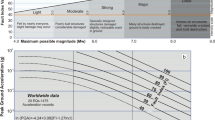Abstract
Engineering risk assessment is to estimate the structure’s failure probability multiplied by its failure consequences. On the other hand, the analysis was sometimes performed on a more general basis, utilizing a few indicators to quantify relative risk levels for decision-making. On the basis of such a framework, this paper introduces a novel risk assessment on 18 active faults in Taiwan, considering the fault’s location, earthquake size and return period from the literature. The result shows that the Chelungpu Fault in central Taiwan has the highest risk score among the 18 active faults, in contrast to the Hengchun Fault in southern Taiwan which has the lowest risk. Besides this, the 18 active faults in Taiwan were classified into four groups based on this risk assessment, and the classification could help the region’s sustainable development against earthquake hazard.







Similar content being viewed by others
References
Cheng CT, Chiou SJ, Lee CT, Tsai YB (2007) Study on probabilistic seismic hazard maps of Taiwan after Chi-Chi earthquake. J Geo Eng 2:19–28
Fenton GA, Griffiths DV (2008) Risk assessment in geotechnical engineering. Wiley, New York
Hsiao NC, Wu YM, Zhao L, Chen DY, Huang WT, Kuo KH, Shin TC, Leu PL (2011) A new prototype system for earthquake early warning in Taiwan. Soil Dynamic Earthq Eng 31:201–208
Hsu YJ, Yu SB, Simons M, Kuo LC, Chen HY (2009) Interseismic crustal deformation in the Taiwan plate boundary zone revealed by GPS observations, and earthquake focal mechanism. Tectonophysics 479:4–18
Keller EA (1996) Environmental geology, 7th edn. Prentice-Hall, New Jersey
Lin CW, Lu ST, Shih TS, Lin WH, Liu YC, Chen PT (2008) Active faults of Central Taiwan. Special publication of central geological survey 21:148 (in Chinese with English abstract)
Lin CW, Chen WS, Liu YC, Chen PT (2009) Active faults of Eastern and Southern Taiwan. Special publication of central geological survey 23:178 (in Chinese with English abstract)
Ota Y, Chen YG, Chen WS (2005) Review of paleoseismological and active fault studies in Taiwan in the light of the Chichi earthquake of September 21, 1999. Tectonophysics 408:63–77
Peng M, Zhang LM (2012a) Analysis of human risks due to dam break floods—part 1: a new model based on Bayesian networks. Nat Hazards 64:903–933
Peng M, Zhang LM (2012b) Analysis of human risks due to dam break floods—part 2: application to Tangjiashan landslide dam failure. Nat Hazards 64:1899–1923
Wang JP, Xu Y (2012) The site selection of the Lungmen nuclear power plant in Taiwan. Int J Archit Eng Const 1:251–256
Wang JP, Chan CH, Wu YM (2011) The distribution of annual maximum earthquake magnitude around Taiwan and its application in the estimation of catastrophic earthquake recurrence probability. Nat Hazards 59:553–570
Wang JP, Huang D, Yang Z (2012a) Deterministic seismic hazard map for Taiwan developed using an in-house Excel-based program. Comput Geosci 48:111–116
Wang JP, Wu YM, Lin TL, Brant L (2012b) The uncertainty of a Pd3-PGV onsite earthquake early warning system. Soil Dyn Earthq Eng 36:32–37
Wang JP, Huang D, Cheng CT, Shao KS, Wu YC, Chang CW (2013a) Seismic hazard analysis for Taipei city including deaggregation, design spectra, and time history with Excel applications. Comput Geosci 52:146–154
Wang JP, Huang D, Chang SC (2013b) Assessment of seismic hazard associated with the Meishan fault in Central Taiwan. Bull Eng Geol Environ 72:249–256
Wu YM, Kanamori H (2008) Development of an earthquake early warning system using real-time strong motion signals. Sensors 8:1–9
Youngs RR, Coppersmith KJ (1985) Implications of fault slip rates and earthquake recurrence models to probabilistic seismic hazard estimates. Bull Seismol Soc Am 75:939–964
Acknowledgments
The authors appreciate the valuable comments from Editor Dr. Culshaw and the reviewers, making this submission much improved in so many aspects. We also appreciate the Ministry of Interior and Central Geological Survey of Taiwan for providing GIS data for the analysis.
Author information
Authors and Affiliations
Corresponding author
Rights and permissions
About this article
Cite this article
Wang, J.P., Wu, MH. Risk assessments on active faults in Taiwan. Bull Eng Geol Environ 74, 117–124 (2015). https://doi.org/10.1007/s10064-014-0600-1
Received:
Accepted:
Published:
Issue Date:
DOI: https://doi.org/10.1007/s10064-014-0600-1




